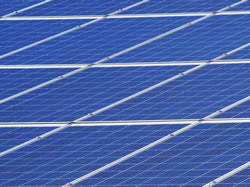 A new study has revealed how researchers at the Australian National University (ANU) achieved a world record in solar cell efficiency.
A new study has revealed how researchers at the Australian National University (ANU) achieved a world record in solar cell efficiency.
Lead researcher at ANU, Tom White said the study focused on ‘perovskite’ solar cells, made using a special group of materials which were cheap and easy to manufacture.
Associate Professor White said the team achieved 21.6 per cent efficiency in converting sunlight into electricity, a new record for perovskite solar cells larger than one square centimetre in size.
“They managed to achieve this breakthrough by adapting a technique which has already proven successful with silicon solar cells,” Professor White said.
“A common problem with solar cells is that any defects in the cell can trap electrons, taking away the energy they gained by absorbing sunlight,” he said.
“A way around this is to “passivate” the surface by coating the light absorbing material with a thin layer of another material to reduce defects.
Professor White said that although the technique worked, the materials used to reduce defects were often poor conductors of electricity.
Research fellow at the ANU College of Engineering & Computer Science, Jun Peng proposed the solution to the problem explaining that “some silicon cells use holes to let the electrons through this insulating layer, creating a kind of conductive pathway.”
“We decided to take a similar approach with our perovskite cells,” Dr Peng said.
“The idea behind it and the reasons it works are the same, but our models showed us that to make it work on perovskite solar cells, we would need to manufacture these holes on the scale of nanometres – thousands of times smaller than is used in silicon,” he said.
Dr Peng said that instead of holes, the team used nanoscale rods that poked through the insulating layer.
The team’s record result was independently verified by the Commonwealth Scientific and Industrial Research Organisation (CSIRO) Photovoltaics Performance Lab.


